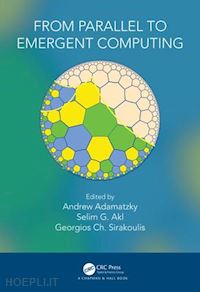Andrew Adamatzky is Professor of Unconventional Computing and Director of the Unconventional Computing Laboratory, Department of Computer Science, University of the West of England, Bristol, United Kingdom. He does research in molecular computing, reaction-diffusion computing, collision-based computing, cellular automata, slime mould computing, massive parallel computation, applied mathematics, complexity, nature-inspired optimisation, collective intelligence and robotics, bionics, computational psychology, non-linear science, novel hardware, and future and emergent computation. He authored seven books, including Reaction-Diffusion Computers (Elsevier, 2005), Dynamics of Crowd-Minds (World Scientific, 2005), and Physarum Machines (World Scientific, 2010), and edited 22 books in computing, including Collision Based Computing (Springer, 2002), Game of Life Cellular Automata (Springer, 2010), and Memristor Networks (Springer, 2014); he also produced a series of influential artworks published in the atlas Silence of Slime Mould (Luniver Press, 2014). He is founding editor-in-chief of the Journal of Cellular Automata (2005–) and the Journal of Unconventional Computing (2005–) and editor-in-chief of the Journal of Parallel, Emergent, Distributed Systems (2014–) and Parallel Processing Letters (2018–). Selim G. Akl (Ph.D., McGill University, 1978) is a Professor at Queen’s University in the Queen’s School of Computing, where he leads the Parallel and Unconventional Computation Group. His research interests are primarily in the area of algorithm design and analysis, in particular for problems in parallel computing and unconventional computing. Dr. Akl is the author of Parallel Sorting Algorithms (Academic Press, 1985), The Design and Analysis of Parallel Algorithms (Prentice Hall, 1989), and Parallel Computation: Models and Methods (Prentice Hall, 1997). He is co-author of Parallel Computational Geometry (Prentice Hall, 1993), Adaptive Cryptographic Access Control (Springer, 2010), and Applications of Quantum Cryptography (Lambert, 2016). Georgios Ch. Sirakoulis is a Professor in Department of Electrical and Computer Engineering at Democritus University of Thrace, Greece. His current research emphasis is on complex electronic systems, future and emergent electronic devices, circuits, models and architectures (memristors, quantum cellular automata, etc.), novel computing devices and circuits, cellular automata, unconventional computing, high-performance computing, cyber-physical and embedded systems, bioinspired computation and bioengineering, FPGAs, modelling, and simulation. He co-authored two books, namely Memristor-Based Nanoelectronic Computing Circuits and Architectures (Springer, 2016) and Artificial Intelligence and Applications (Krikos Publishing, 2010) and coedited three books.












